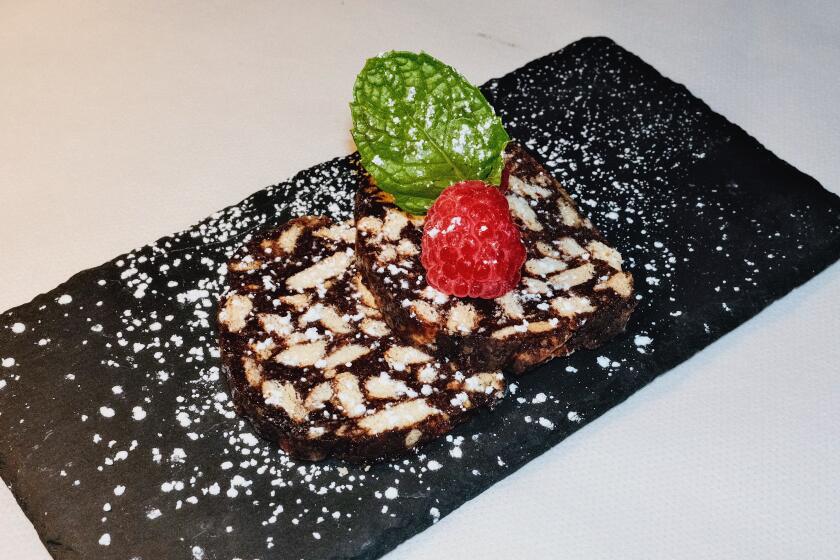Hazelnut Honey Squares

- Share via
Tzimmes and sweet tajines come from very different places--the first is a specialty of Ashkenazi Jews from eastern and central Europe, the latter are made by Sephardic Jews from Morocco--but they have things in common. Not least is the fact that these slow-cooked stews, frequently featuring meat and dried fruit, make perfect meals for Rosh Hashana, the Jewish New Year that begins this year on Monday evening.
In the Ashkenazi home where I grew up, tzimmes appeared frequently at family celebrations, especially on Rosh Hashana, when eating sweet foods is customary in hopes of having a sweet year. It wasn’t until years later in Paris that Moroccan Jewish friends introduced me to tajine.
There are two main types of tajine . Spicy tajines, with seasoned with garlic, cumin and red pepper, are generally meat and vegetable stews. Sweet tajines use sweet spices and replace the vegetables with fruit.
What surprised me was how much sweet tajines resembled tzimmes . Both cook meat with dried fruit and honey in an onion-flavored broth. The effect is sweet, not sweet and sour; they contain no lemon juice, vinegar or other acidic ingredient, which some people avoid on the Jewish New Year--another reason why both are perfect for the occasion.
The main differences between sweet tajines and tzimmes are in the accents. The tajines always have complex spicing--usually saffron, cinnamon or both, often nutmeg and ginger as well, sometimes a touch of turmeric--which beautifully balances their sweetness. Many Ashkenazi cooks, on the other hand, season their tzimmes with nothing but salt and pepper. (I’m with those who add a pinch of cinnamon, nutmeg or cloves.)
Tajines are thickened by simmering until the liquid reduces and the taste is concentrated. Tzimmes are more likely to be served with plenty of liquid, thickened only with a little flour.
Beef cuts such as brisket or chuck are the classic tzimmes meat. (Today many cooks substitute chicken because it’s lower in fat.) Lamb and chicken are preferred in tajines .
Unlike tzimmes , tajines are not exclusively Jewish. Other North Africans make tajines , though they might add butter, which Jews do not, since it would make these meaty dishes non-kosher.
Honey is the sweetener of choice. Moroccan cooks rarely use anything else, though Ashkenazi cooks are almost as likely to use brown or even white sugar. How sweet to make the dishes depends on family taste. My mother sweetens tzimmes with a light hand, and that’s how I make tajines, too.
Both tzimmes and sweet tajines usually contain fruit. Prunes are by far the most traditional, though Moroccans use raisins nearly as often and may even include dried apricots and dates and fresh quinces, apples and pears. A garnish of fried almonds or toasted sesame seeds provides a wonderful accent.
Vegetables are more likely to show up in a tzimmes than in a tajine . Carrots and sweet potatoes are the most common, followed by white potatoes. Turnips might appear in the tzimmes pots of French Jews, rutabaga in England.
In Morocco, vegetables are not characteristic of sweet tajines . If one is added--and there will be only one kind--it might be sweet potatoes or carrots, as in tzimmes , or occasionally pumpkin or tomatoes. When a sweet tajine is made with a vegetable, fruit (apart, perhaps, from raisins) will be omitted.
Neither dish is carved in stone. Still, I don’t tamper with these age-old favorites too much, particularly during the holidays, when the most important ingredient is tradition.
Faye Levy is author of “1,000 Jewish Recipes” (Hungry Minds, $35).
Heat the oven to 350 degrees. Lightly grease a 9-inch square pan, line it with parchment paper or wax paper and grease the paper.
Sift the flour with the baking powder, baking soda, cinnamon and cloves.
Beat the eggs lightly in a mixer bowl. Add the sugar and honey and beat until the mixture is smooth and lightened in color, 1 to 2 minutes. Gradually add the oil and beat until blended. Add the lemon and orange zests and beat briefly. On low speed, beat in the flour mixture alternately with the applesauce, each in 3 portions. Add the nuts and beat just until blended.
Pour the batter into a pan. Bake until a cake tester inserted in the center of the cake comes out clean, 55 to 65 minutes. Cool in the pan for 15 minutes. Turn out onto a rack and carefully peel off the paper. Cover tightly when completely cool. Serve at room temperature. Cut in squares or bars.
Get our Cooking newsletter
Get a taste of Los Angeles — and the world — with recipes and kitchen tricks from the L.A. Times’ Cooking newsletter.
You may occasionally receive promotional content from the Los Angeles Times.















